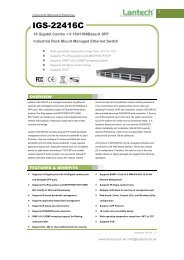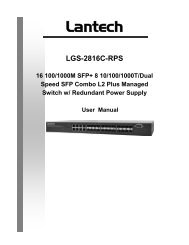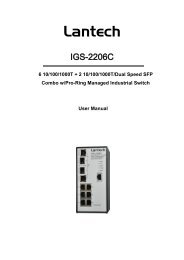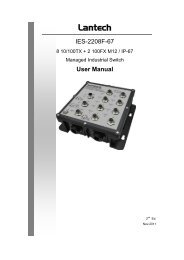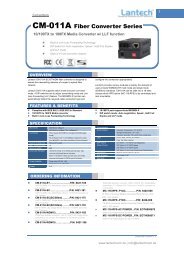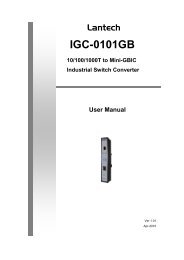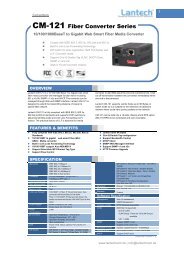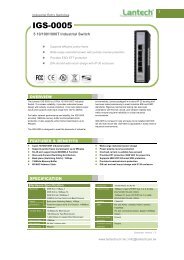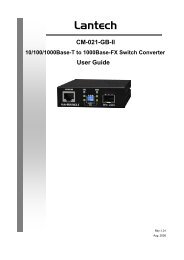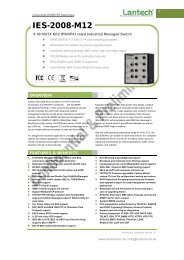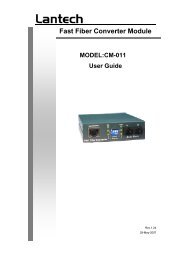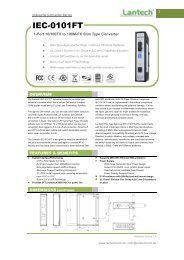Product Guide 2012 - Lantech Communications Global Inc
Product Guide 2012 - Lantech Communications Global Inc
Product Guide 2012 - Lantech Communications Global Inc
Create successful ePaper yourself
Turn your PDF publications into a flip-book with our unique Google optimized e-Paper software.
UL C1D2 & DNVTypical Oil, Gas & Mining applications that require UL Class I Division II certification:UL C1D2 & DNVNowadays Industrial Ethernet switches and Industrial Ethernet based devices aremore suitable for their environments and applications; they are designed to meetthe riggers of the task at hand which in some cases includes a harsh environmentlike Oil, Gas and Mining industry.Some of the facilities that would utilize equipment that would fall into thisapplication environment would be Oil Refineries, Oil Platforms andPetro-Chemical Plants these types of facilities would have a need to installIndustrial Ethernet based switches and devices for process control andmonitoring. These types of facilities require devices that are certified to meet theharsh environments they produce.For example, in the Petro-Chemical industry, controlling and monitoring siteconditions and dynamic changes in those conditions are mission critical. Thedevices and more importantly the network which is made up of Ethernetswitches, Media Convertors, Routers, Gateways and Fiber Optic cables arecombined to allow these devices to communicate these changes; the combined devices and componentsmust be of a mission critical nature as well and it must be able to withstand the rigorous challenges of itssurroundings. Thus the need and the absolute promise of the “UL Class I Division II” certification of thenetwork equipment or the Industrial Ethernet based switches and devices. At this level of severity, the riskfor loss of life and property is at its highest and this certified equipment provides reliable, secure and rapiddata transmission, so that the administrators controlling and monitoring the plant’s activities can detect anyabnormal situations quickly enough for them to take the necessary actions to prevent an accident or adisaster.In order to overcome these hazardous environments, the relative device should pass a variety of testing andcertification. These devices face some pretty tough conditions. While striving to maintain high safetystandards and efficient operating costs, companies demand rugged protection for the critical equipmentthat controls power generation and distribution. These test and certifications including the extremetemperature, IP rating and three kinds of stability test (free-fall, vibration, shock), with a certain degree ofresistance to shock, vibration-resistant properties that ensure the normal functionality under harshenvironments. With “UL Class I Division II” approval, Ethernet switch and devices can be deployed inhazardous or explosive condition without increasing the risk of explosion or acceleratingthe damage if an accident occurs.UL Class I Division II & DNVSeveral harsh environment certifications have been established by third party testingagencies, one such certification is “UL Class I Division II” this is one of the most widely usedby the most trusted names of the testing agencies. Underwriters Laboratories (UL) is oneof the testing agencies that certifies these types of systems as safe for use in the highestlevel of hazardous locations; these types of locations would include but not be limited topotentially explosive location or location where all electronic circuits and / or devices mustbe intrinsically safe. An Intrinsically Safe Circuit is "A circuit in which any spark or thermal effect is incapableof causing ignition of a mixture of flammable or combustible material in air under prescribed testconditions." (See UL 913)P19DNV Certification for Maritime Oil & GasAnother such testing agency similar to UL is DNV (Det Norske Veritas), DNV is a classification societyorganized as a foundation, with the objective of "Safeguarding life, property, and the maritimeenvironment". DNV’s approval process entails verification of a set of requirements and processes; theserequirements and processes encompass the design, construction, and operation of devices used on-boardships and offshore units. DNV has four levels-A, B, C, and D of classification of their tests. These would rangefrom the most basic to the most critical and separate tests are conducted for other types of conditions(temperature, humidity, vibration, etc.). The use of Ethernet based devices combined with a fiber optic backbone make it much easier for the control center to coordinate and control data from many different systemsover a common communication platform. Any such network in use aboard a offshore platform or maritimevessel, would be subject to have passed the DNV’s strict testing procedures and processes; this wouldinclude all the Ethernet based devices proving the worthiness in the Maritime Oil & Gas Industry. Being oneof the world's leading classification societies, DNV’s certification are recognized globally as an indication thata product is fit for use in the well-defined classes of marine environments and applications.




